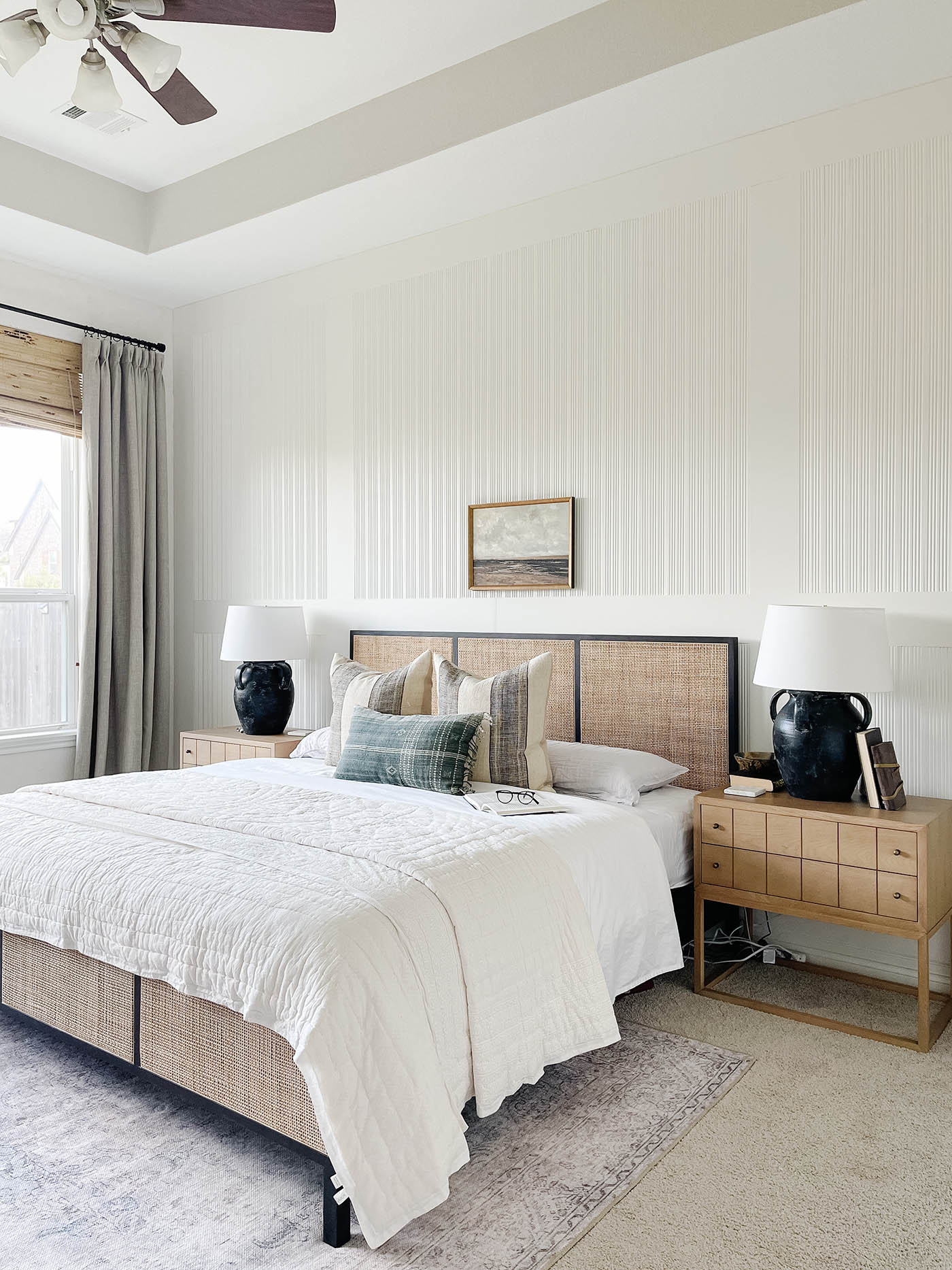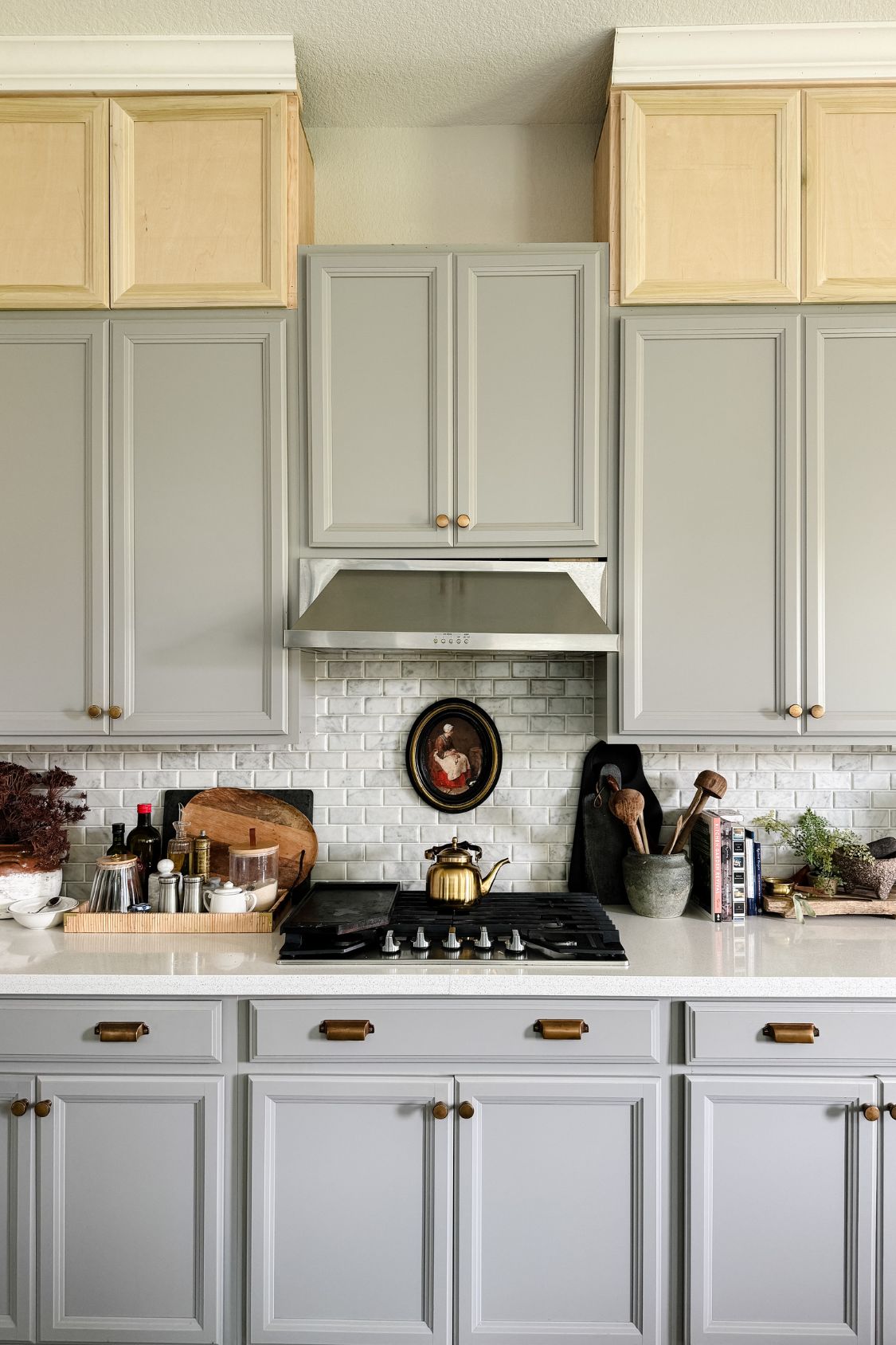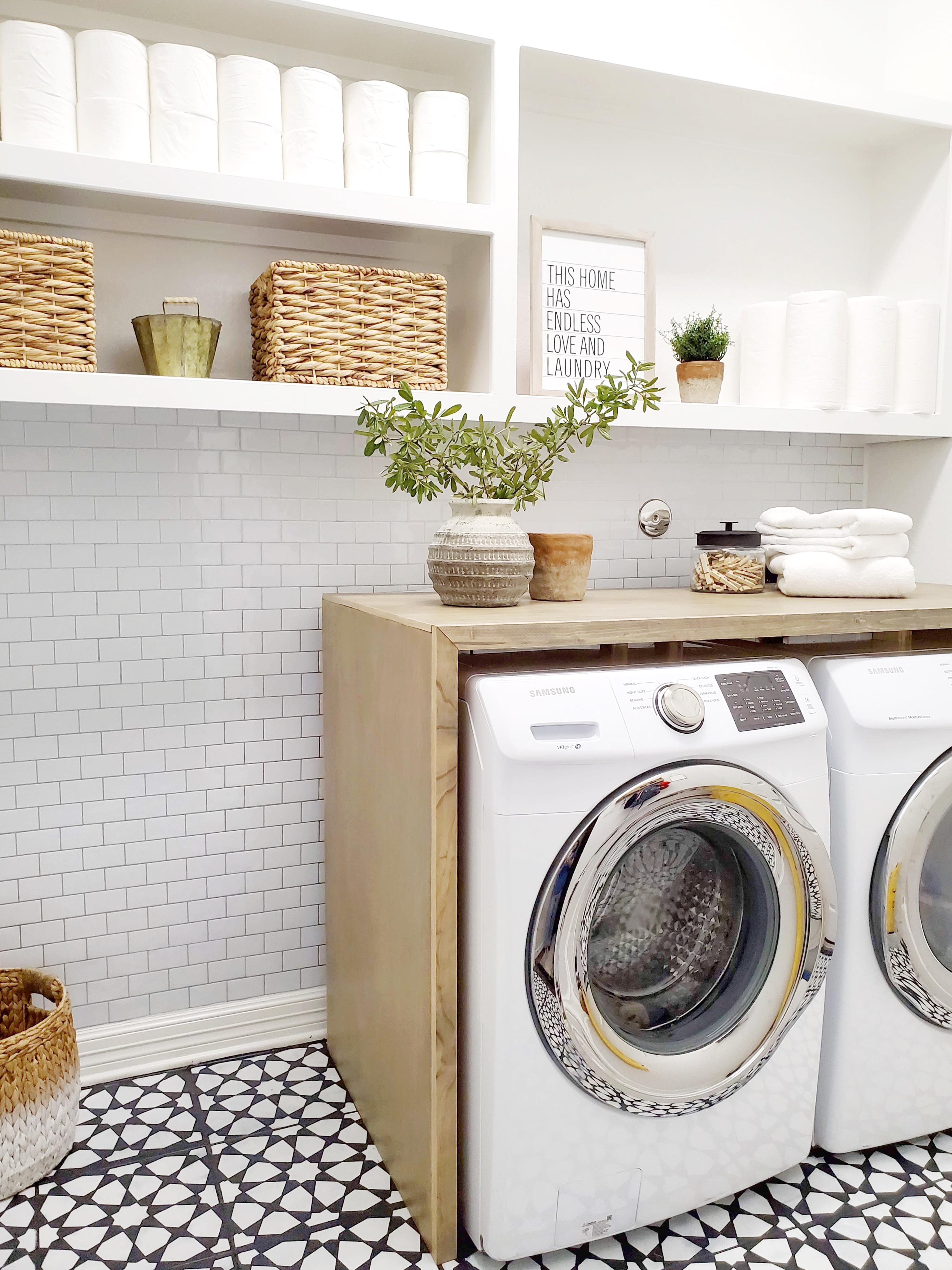Easy DIY Sound Absorbing Panels for Your Home Theater
Table of Contents Show
Creating a home theater is more than just buying the best screen and surround sound system; it’s about crafting an immersive experience. But nothing kills the cinematic vibe faster than poor sound quality. That’s where DIY sound absorbing panels come in. This blog post will show you exactly how to make your own DIY sounds absorbing wall panels, the easiest way!
If you’ve ever shopped for pre-made acoustic panels, you know how pricey they can get. A few years ago, my husband and I took the DIY route for our media room, and we’ve never looked back. We built our own acoustic panels using basic supplies from Home Depot, and they look just as good as they sound. Not only do they blend seamlessly into the room, but we also added designer touches like picture frame molding and wall sconces between each panel for a cozy, elevated finish.
Whether you’re building a home studio, home gym, band room, or just want a quieter living room or workout room, this tutorial is your go-to guide. You’ll learn how to make beautiful, affordable, and effective sound absorption panels that improve acoustics and your decor.
What Are Sound Absorbing Panels?

Sound absorption panels, also known as acoustic panels, are designed to reduce echo and background noise by trapping sound waves. They help control unwanted reflections, especially in rooms with concrete floors, brick walls, or other hard surfaces. While they’re common in control rooms and recording studios, they’re just as effective in home theaters, open-concept living rooms, and even noisy bedrooms. It’s an effective way to keep outside sound out and inside sound in.
Why Build Your Own Acoustic Panels?
Buying pre-made acoustic panels can cost hundreds or even thousands of dollars. But here’s the thing: the materials themselves are inexpensive. With a little time, basic tools, and some good quality fabric, you can build DIY acoustic panels that offer:
- A custom look that matches your home’s style
- Significant improvement in sound clarity
- An inexpensive way to regulate ambient noise
- Flexibility to fit your room modes, size, and design vision
Supplies You’ll Need (All from Your Local Hardware Store)
Here’s a complete list of tools and materials to build your own DIY sound panels. Most can be sourced from Home Depot or your nearest local hardware store.
Materials:
- Rockwool Safe n Sound insulation or Owens Corning 703 for Sound Absorption
- 1×4 Select Pine Wooden Boards or MDF Board for The Frame
- Acoustic Fabric or Speaker Cloth (Optional: Guilford of Maine fabric for high-end look)
- Wood Glue
- Staple Gun and Staples
- Drywall Anchors or Screw Eye Hooks
- Adhesive Spray (optional for securing insulation)
- 1×2 Support Strips for Back Reinforcement
- Fiberglass Screen Roll
Tools:
- Tape measure
- Circular saw or miter saw
- Drill and drill bits
- Pilot holes for easier screwing
- Right angle clamps
- Screwdriver or impact driver
- Stud finder
- Eye protection and face mask
- Straight edge or level
Step-by-Step: How to Build Your Own DIY Acoustic Panels
First Step: Plan Your Layout
The first thing you do is identify the number of panels you need based on the size of your space. Focus on areas where sound waves are most reflective: behind speakers, across from them, or in corners for bass traps. Use a laser level or painter’s tape to map it out on your wall first.
Cut the Wooden Frame
The next step is to cut your wooden boards (both 1x4s or 1x3s work great) to size. For standard panels, we used 24 x 48 inch dimensions. Use a circular saw or miter saw to cut and right angle clamps to ensure perfect 90 degree corners.
Assemble the Frame


Use wood glue and wood screws to secure the long side to the shorter one. Pre-drill pilot holes to avoid splitting the wood. Reinforce with support strips across the back of the frame for sturdiness.
Add Sound Absorbing Material and Screen Roll


Insert your Rockwool Safe n Sound or Owens Corning 703 into the inside of the frame. For best results, use a thicker panel between 2 to 4 inches depending on your frequency range concerns. Optionally, use adhesive spray to secure the insulation to the back of the panel. Staple the fiberglass screen roll onto the front of the panel to secure the insulation material.
Wrap the Frame with Acoustic Fabric and Install
Lay the acoustic fabric face down on a flat surface. Center the completed frame and pull the fabric taut around it. Staple along the back of the frame using a staple gun. Trim excess fabric.
Fabric Tip: Choose solid colors to match your walls. We used a navy blue fabric which matches the wall color – Sherwin-Williams Inkwell, for a seamless, upscale look.
Optional: Add Picture Frame Molding for a Designer Look

Cut and install picture frame molding around the front edge of the panel for dimension. Paint molding to match or contrast for visual impact. You can read all about that DIY project here.
Install the Panels

To complete the entire process you can hang your DIY acoustic panels with drywall anchors or screw eye hooks. Use a stud finder to locate safe mounting points on interior walls. If you’re mounting between wall sconces, space them evenly across the entire wall for balance.
Where Can You Use DIY Acoustic Panels?
You don’t need a control room or recording studio to benefit from acoustic treatment. Here are smart places to install your own sound panels:
- Home theater: Dramatically reduce background noise and improve clarity
- Workout room or home gym: Dampen loud echoes from equipment
- Home studio or podcast setup: Minimize high frequencies and reflections
- Band room or music practice space: Better frequency range control
- Living room or open concept spaces: Soften echoes from concrete floors or a brick wall
- Bedrooms or nurseries: Create a quieter, more peaceful space
Designer Touch: Why These Don’t Just Look DIY

When we installed ours, we intentionally chose fabric that matched our paint color, framed each panel with wall molding, and installed wall sconces between each panel for a luxe, built-in look. The result is a room that feels designed, not DIY-ed. This method is perfect for anyone looking to combine form and function without paying the markup on pre-made acoustic panels. If you’re still wondering if you should buy pre-made or DIY these acoustic wall panels, here’s a quick cost breakdown:
Cost Breakdown: DIY vs. Buying
| Item | DIY Panels (Each) | Pre-Made Panels (Each) |
| Materials (Rockwool, Wood, Fabric) | $35–$50 | $150–$300+ |
| Custom Design and measurements | ✅ | ❌ (Limited Styles) |
| STC Ratings/Soundproofing | ✅ (With Rockwool/OC703) | ✅ |
| Time Commitment | 1-2 hrs/panel | 0 (Shipped) |
| Design Flexibility | 100% | Minimal |
Even with added upgrades like molding and sconces, we outfitted our entire room for a fraction of the cost.
Tips for Choosing the Right Fabric
Acoustic panels require fabric that allows sound to pass through to the insulation. Avoid vinyl, leather, or tightly woven upholstery fabric. Test breathability by placing the fabric over your mouth and blowing through it. If air passes easily, it is suitable for acoustic use. Speaker cloth, burlap, and Guilford of Maine are popular choices. Solid color linen blends or cotton-poly blends also work well and come in a variety of hues to match your space.
FAQs about Sound Absorbing Wall Panels DIY Project:

What’s the best material for sound absorption?
Mineral wool like Rockwool Safe n Sound or Owens Corning 703. They are dense, safe for interiors, and absorb across a wide frequency range.
What fabric works best?
Choose breathable fabric like acoustic fabric, speaker cloth, or cotton/poly blends. If you can breathe through it, it works for sound absorption.
How thick should my panels be?
At least 2 inches thick, ideally 4 inches for bass traps or rooms with poor sound quality.
Can I paint the fabric or cover it with wallpaper?
Not recommended. Paint and wallpaper block sound from passing through to the insulation. Instead, pick a solid color fabric that complements your space.
How many panels do I need?
Depends on the size of the room, ceiling height, and layout. As a general idea, start with 4 to 6 panels for a small room, and scale up to 12 or more for larger home theaters or band rooms.
Will these help with thermal insulation too?
Yes. Mineral wool also adds a layer of thermal insulation, which can help regulate temps in rooms with concrete floors or brick walls.
I’m short on tools. Can I still do this?
Yes. The easiest strategy is to ask your local Home Depot to cut your wood to size. You’ll only need basic tools like a drill, staple gun, and tape measure at home.
What if I have an oddly shaped wall or limited space?
You can absolutely make acoustic panels in a different size. Measure your space carefully and use the same techniques to build smaller or narrower panels that still offer sound control.
How do these panels compare to foam tiles?
Foam tiles can help reduce high frequencies but are not as effective as thick panels made from mineral wool. Foam also tends to deteriorate over time and lacks the design flexibility of fabric-wrapped panels.
Can I make free-standing panels?
Yes. Use wider wooden boards for the base and secure the frame vertically. Freestanding panels are great for temporary setups or rental spaces where you cannot mount to walls.
Building your own DIY acoustic panels is one of the most effective ways to transform the acoustics in your home while adding a custom, designer touch. Whether you’re upgrading a home theater, setting up a home studio, or trying to soften a noisy room, this project brings a huge difference with little effort. You don’t need to sacrifice design for performance. Just a little bit elbow grease, thoughtful materials, and a plan will take you in the right direction even on a tight budget.
Next, you can learn how to add picture frame molding to your space to elevate the look of your room or read more about our media room makeover!
This post contains affiliate links to products that I used or recommend. If you purchase something through an affiliate link, I may receive a small percentage of the sale at no extra cost to you. I really appreciate your support!







